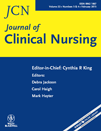Long-term urinary catheter users self-care practices and problems
Abstract
Aims and objectives
To characterise a sample of 202 adult community-living long-term indwelling urinary catheter users, to describe self-care practices and catheter problems, and to explore relationships among demographics, catheter practices and problems.
Background
Long-term urinary catheter users have not been well studied, and persons using the device indefinitely for persistent urinary retention are likely to have different patterns of catheter practices and problems.
Design
The study was a cross-sectional descriptive and exploratory analysis.
Methods
Home interviews were conducted with catheter users who provided information by self-reported recall over the previous two months. Data were analysed by descriptive statistics and tests of association between demographics, catheter practices and catheter problems.
Results
The sample was widely diverse in age (19–96 years), race and medical diagnosis. Urethral catheters were used slightly more often (56%) than suprapubic (44%), for a mean of six years (SD 7 years). Many persons were highly disabled, with 60% having difficulty in bathing, dressing, toileting and getting out of the bed; 19% also required assistance in eating. A high percentage of catheter problems were reported with: 43% experiencing leakage (bypassing of urine), 31% having had a urinary tract infection, 24% blockage of the catheter, 23% catheter-associated pain and 12% accidental dislodgment of the catheter. Treatments of catheter-related problems contributed to additional health care utilisation, including extra nurse or clinic visits, trips to the emergency department or hospitalisation. Symptoms of catheter-associated urinary tract infections were most often related to changes in the colour or character of urine or generalised symptoms.
Conclusions
Catheter-related problems contribute to excess morbidity and health care utilisation and costs.
Relevance to clinical practice
More research is needed in how to minimise catheter-associated problems in long-term catheter users. Information from this study could help inform the development of interventions in this population.




